allclene said:Was looking at your rig very nice! have one question, I noticed you have your pump inputs on the bottom. Do you have a problem with priming that way? do you think it would work if the pumps were turned 180 degrees?
That is how march says to set up the pumps. However, I am currently fighting with some priming issues.... I've built a nearly identical rig



